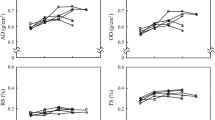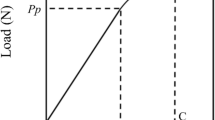Summary
Forty lobiolly pine trees were studied for the purpose of finding a possible reason for the growth rate-specific gravity controversy. In addition, properties such as specific gravity of earlywood and latewood, latewood percentage, and their relations with growth rate and specific gravity of wood were investigated.
The results show that, in general, significant relationship do exist between specific gravity and number of rings per inch for growth rates ranging from approximately 3...8 rings per inch. Specific gravity was generally unrelated with slower growth rates, i.e., more than 8 rings per inch.
Specific gravity of specimens having the same number of rings per inch varied according to height-decreasing with increasing height. Latewood percentage was related to number of rings per inch in a similar manner as specific gravity. Within a tree, latewood percentage of wood having the same number of rings per inch decreased with increasing height.
Negative relationships between earlywood specific gravity and number of rings per inch were found to be significant for the 30 percent height and for all heights when combined. However, there was no significant relationship between latewood specific gravity and number of rings per inch. Average laterwood specific gravity decreased with height. Earlywood specific gravity only decreased from 5.3...30 percent height levels and then showed an increase. In general, wood properties such as specific gravity and latewood percentage of wood, specific gravity of earlywood and latewood, varied more from breast height to approximately the 30 percent height, than between equal distances above the 30 percent height level.
Similar content being viewed by others
References
Fry, G.,Chalk, L. 1957. Variation in density of wood ofPinus patula grown in Kenya. Forestry30: 29–45.
Goggans, J. F. 1962. The correlation, variation, and inheritance of wood properties in Loblolly pine. North Carolina State College. School of Forestry Tech. Rept. 14.
Larson, P. R. 1957. Effect of environment on the percentage of summerwood and specific gravity of Slash pine. Yale School of Forestry Bull. 63.
Miller Jr., S. R. 1959. Variation in inherent wood characteristics in Slash pine. Proc. 5th Southern Conf. Forest Tree Improvement: 97–106, North Carolina State College. School of Forestry. Raleigh.
Paul, B. H., Smith, D. M. 1950. Summary of growth in relation to quality of Southern yellow pine. USDA. FPL Rept. D1751.
Ralston, R. A.,McGinnes, Jr., E. A. 1964. Shortleaf pine wood density unaffected by ring growth. Southern Lumberman.208, (2592): 17–19.
Risi, J., Zeller, E. 1960. Specific gravity of the wood of black spruce (Picea mariana, Mill. B. S. P.) grown on a Hylocomium-Cornus site type. Laval Univ. Forestry Research Foundation Contribution 6, Quebec, Canada.
Schafer, E. R. 1949. Influence of volume of summerwood and rate of growth on the specific gravity of southern pine pulpwood. Southern Pulp Paper Mfr.12: 166–168.
Schniewind, A. P. 1961. The effect of site and other factors on specific gravity and bending strength of California red fir. Forest Sci.7 (1): 106–115.
Smith, D. M. 1956. Effect of growth zone on specific gravity and percentage of summerwood in wide-ringed Douglas-fir. USDA. FPL Rept. 2057.
Spurr, S. H.,Hsiung, W. Y. 1954. Growth rate and specific gravity in conifers. J. Forestry.52 (3): 191–200.
Turnbull, J. M. 1948. Factors affecting wood density in pines. S. African Forestry. J.16: 22–43.
Van Buijtenen, J. P.,Zobel, B. J.,Jorenson, P. N. 1961. Variation of some wood and pulp properties in an even aged Loblolly pine stand. Tappi44 (2): 141–144.
Wellwood, R. W. 1960. Specific gravity and tracheid length variations in second-growth western Hemlock. J. Forestry58 (5): 361–368.
Yao, J. 1968. Modified mercury immersion method in determining specific gravity of small, irregular wood specimens. For. Prod. J.18 (2): 56–69.
Zobel, B. J.,McElwee, R. L. 1958. Natural variation in wood specific gravity of Loblolly pine and an analysis of contributing factors. Tappi41 (4): 158–161.
—,Webb, C.,Henson, F. 1959. Core or juvenile wood of Loblolly and Slash pine trees. Tappi42 (5): 345–356.
Author information
Authors and Affiliations
Rights and permissions
About this article
Cite this article
Yao, J. Influence of growth rate on specific gravity and other selected properties of loblolly pine. Wood Sci.Technol. 4, 163–175 (1970). https://doi.org/10.1007/BF00571851
Received:
Issue Date:
DOI: https://doi.org/10.1007/BF00571851




